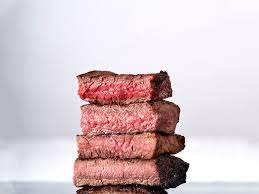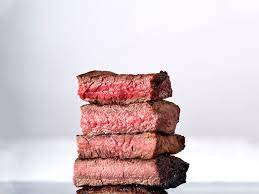Beef is one of the most popular meats around the world, and has been a staple food for thousands of years. From its origins as a source of protein for early human populations to its place as a mainstay of modern cuisine, beef has played an important role in human nutrition and culture. In this blog, we’ll explore the history, benefits, and drawbacks of beef, as well as some popular beef recipes and nutritional information.
Origin and History of Beef
It has been a source of food for humans for thousands of years. Early humans hunted wild cattle for meat and eventually began domesticating and raising them for food. Also, it has been a part of human diets for thousands of years. In ancient times, cattle were used for milk, meat, and as draft animals. The domestication of cattle made it easier for humans to obtain a consistent supply of meat and dairy products. Today, it is an important part of many cuisines around the world and is consumed in a variety of forms and preparations.
Everything About Beefs
This is meat that comes from cattle, including cows, bulls, and steers. It is a rich source of protein, iron, and other essential nutrients. It can be prepared in a variety of ways, including grilling, roasting, frying, and stewing. There are many different cuts of this dish, each with its own flavor and texture.
Various Ways to Make Beef
It can be prepared in a variety of ways, depending on the cut and the desired outcome. Some popular beef dishes include steak, burgers, meatballs, pot roast, and beef stroganoff. Which can be cooked on a grill, in an oven, or on the stovetop, and can be seasoned with a variety of herbs and spices. There are also many cultural and regional variations of beef dishes, such as tacos, kebabs, curries, and roasts.
Benefits and Disadvantages
This is a rich source of protein, iron, and other essential nutrients. However, it is also high in saturated fat and calories, and consuming too much can increase the risk of heart disease and other health problems. Additionally, the environmental impact of its production can be significant, as cattle require large amounts of water and produce greenhouse gases.
Benefits of Eating Beef Every Day
While consuming this every day is not recommended, incorporating it into your diet in moderation can have some health benefits. This is a good source of protein, which can help build and repair muscle tissue. It also contains iron, which is important for red blood cell production and immune function.
What Cow Meat is Called
This is the meat that comes from cattle, including cows, bulls, and steers. Other types of meat that come from cattle include veal, which comes from young calves, and lamb, which comes from sheep.
Benefits for Females
This is a good source of iron, which is essential for the production of red blood cells. It is important for women who are pregnant or menstruating, as they may be at risk for iron deficiency anemia.
Benefits for males
This is an excellent source of protein, which is essential for muscle growth and repair. Men, in particular, can benefit from the high-quality protein in this dish as they tend to have higher muscle mass than women. Additionally, it is rich in iron, which is important for the production of red blood cells and can help prevent anemia. Iron is also essential for the proper functioning of the immune system and helps reduce fatigue and weakness.
What to Eat with Beef
They can be paired with a variety of side dishes, including vegetables, potatoes, rice, and pasta. Some popular accompaniments to beef dishes include roasted vegetables, mashed potatoes, and steamed rice.

Recipes and Calories of Beef
There are countless recipes available, ranging from simply grilled steaks to complex beef bourguignon. The calorie content of beef dishes can vary widely depending on the preparation and ingredients used. The calorie content of beef varies depending on the cut and preparation method. A 3-ounce serving provides approximately 150-180 calories. However, fattier cuts such as ribeye or prime rib can contain over 300 calories per serving.
Popular Beef Dishes
Beef is a versatile protein that can be used in a variety of dishes, ranging from hearty stews and soups to grilled steaks and burgers. Here are some popular beef dishes that you may want to try:
- Steak: Perhaps the most popular beef dish of all, steak is a classic that can be cooked in many ways, such as grilled, pan-seared, or broiled. Some popular cuts include ribeye, sirloin, and filet mignon.
- Beef Stew: This comforting dish is made with beef chunks simmered in a flavorful broth along with vegetables like potatoes, carrots, and onions. It’s perfect for a cold winter night and can be served with crusty bread or over rice.
- Meatballs: Meatballs can be made with ground beef, breadcrumbs, herbs, and spices. They can be served as an appetizer or added to pasta dishes, soups, or sandwiches.
- Burgers: Burgers are a classic American dish made with ground beef, formed into patties, and grilled or fried. They can be customized with a variety of toppings, including cheese, lettuce, tomato, and condiments like ketchup and mayo.
- Tacos: Tacos are a popular Mexican dish made with seasoned ground beef, lettuce, tomatoes, and cheese, all wrapped in a soft or crispy tortilla.
More Info
- Beef Stir-Fry: This quick and easy dish is made by stir-frying beef with vegetables like peppers, broccoli, and onions, in a sauce made of soy sauce, ginger, garlic, and other seasonings. It’s typically served over rice or noodles.
- Roast Beef: This is a classic Sunday dinner dish, made by slow-cooking a large cut of beef in the oven with vegetables like carrots, onions, and potatoes. It can be served with gravy and horseradish sauce.
- Beef Kebabs: Kebabs are a popular Middle Eastern dish made with marinated beef skewered with vegetables like peppers and onions and grilled to perfection.
- Beef Curry: Curry is a popular Indian dish made with tender chunks of beef in a spicy sauce made of onions, tomatoes, and a blend of fragrant spices like cumin, coriander, and turmeric. It’s typically served with rice or naan bread.
- Beef Pho: Pho is a traditional Vietnamese noodle soup made with this dish broth, rice noodles, thinly sliced beef, and fresh herbs and vegetables like bean sprouts and cilantro.
These are just a few of the many delicious dishes out there. Whether you’re in the mood for a juicy steak or a comforting bowl of stew, it is a versatile protein that can be used in a variety of dishes to satisfy your cravings.
Health Benefits and Nutritional Values
This is a good source of protein, iron, and other essential nutrients. It also contains zinc, vitamin B12, and niacin. However, it is important to note that it is high in saturated fat and calories. So it should be consumed in moderation as part of a balanced diet. These nutrients play important roles in supporting overall health and well-being. Including promoting muscle growth and repair, supporting the immune system, and maintaining healthy skin, hair, and nails.
In addition to its nutrient content, it also contains antioxidants. Such as vitamin E and selenium, which can help protect against cellular damage and reduce the risk of chronic diseases. Such as cancer and heart disease.
Frequently Asked Questions
Q: What is the difference between grass-fed and grain-fed beef?
A: Grass-fed beef comes from cattle that have been raised on a diet of grass and other forage. While grain-fed beef comes from cattle that have been fed a diet of grains and other concentrated feeds. Grass-fed beef tends to be leaner and has a more distinct flavor than grain-fed beef.
Q: Is it safe to eat raw beef?
A: Eating raw or undercooked of this dish can increase the risk of foodborne illness. So it is generally not recommended. Beef should be cooked to an internal temperature of 145°F to kill any harmful bacteria.
Q: How should I store beef?
A: It should be stored in the refrigerator at a temperature of 40°F or below. It should be consumed within 3-5 days of purchase, or frozen for longer storage.
Q: Is beef good for weight loss?
A: It can be a part of a healthy diet for weight loss, as it provides high-quality protein and essential nutrients. However, it’s important to choose lean cuts and control portion sizes to avoid consuming too many calories.
Conclusion
This has been a staple food for thousands of years. And continues to be a popular and versatile ingredient in modern cuisine. While it is a rich source of protein and other essential nutrients. It is also high in saturated fat and calories and should be consumed in moderation as part of a balanced diet. There are many different ways to prepare this dish. It can be enjoyed as part of a variety of dishes and cuisines. By understanding the history, benefits, and drawbacks of this dish, we can make informed decisions about incorporating it into our diets. While there are some potential disadvantages, the benefits of including it in a balanced diet are significant. Whether you prefer a juicy steak, a hearty stew, or a spicy stir-fry. There are countless ways to enjoy its flavor and nutritional value of it.
See Also: https://infoblog4all.com/coq-au-vin/

